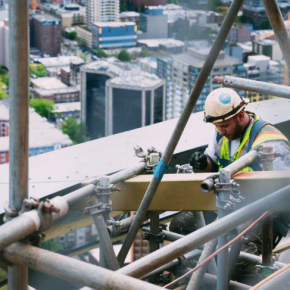
GUEST ARTICLE: What Does Health and Safety Look Like in Construction in 2018?
This article from businessman Luke Conod looks at where we currently stand in regards to all areas of onsite safety, as well as what is in store for the industry looking ahead.
“For as long as there have been buildings constructed, health and safety have always been important – and especially so in the modern age, thanks to advances in technology that allow construction to be a far safer endeavour than in previous centuries.
The health and safety landscape is always changing and reacting to new technology and legislation. Below, we’ll take stock of where we are with regards to every aspect of onsite safety – and what the future holds for the industry.
Augmented and virtual reality
You might think that AR and VR are simple gimmicks used in mobile phone apps and in gaming, but recent advances in machine learning technology have allowed for these technologies to proliferate in the construction sector.
AR is used to combine the design and construction processes, so onsite operators can see what needs to be built alongside vital metrics. American startup DAQRI is pioneering this, with their Worksense AR headsets that can allow workers to virtually tag objects onsite, sharing vital information instantly with management and other workers using their headsets – making safety-related issues much easier to flag.
In terms of VR, the ever-decreasing cost of the technology means that it’s being used more and more in workplace hazard training. VR training scenarios use real BIM (Building Information Modelling) data for added realism, to make sure workers are fully immersed in the safety briefing.
The evolution of PPE
Personal Protective Equipment is a vital safety consideration for any site, and there have been advances galore on this front over the last few decades. In days gone by, PPE simply meant a hard-wearing pair of jeans, for example, and some durable gloves for tough jobs – but while these elements are still undoubtedly important, thankfully, legislation has meant that PPE is very different now.
Compulsory hard hats, eye protection and high-visibility workwear made from advanced water-resistant fabrics are now ubiquitous. Wearable tech is a new frontier on the PPE scene, symbolising a key shift in how PPE is thought of – far from being the last line of defence from an accident, PPE integrated with sensors can alert the wearer to potential dangers before they happen.
The holistic side
Health and safety best practice isn’t just about preventing accidents and training staff to avoid dangerous situations – construction companies need to cast an eye over the mental and holistic wellbeing of their workforce to avoid problems further along the line.
Willmott Dixon’s recent commitment to training 130 mental health first aiders is welcome news in the industry, especially given the recent upswing in mental health awareness all across the UK media. The company highlighted the fact that 85% of the UK construction workforce feel that mental health issues are not adequately addressed.
Taking a holistic approach to health and safety and incorporating mental health as a key segment is very important – and is arguably the most important aspect of the current state of health and safety.
The temptation might be there to utilise advanced safety technology to demand more from their employees, but this risks disharmony and accidents – so taking this holistic and measured approach makes the best sense for onsite worker and boardroom decision-maker alike.
Latest news

21st February 2025
ASSA ABLOY EMEIA: Save valuable time and money with a seamless switch to programmable digital keys
In 2025, access management can be a whole lot easier. By making access part of their digital processes, businesses can put time-consuming key management and the cost of changing the locks firmly behind them. Making this switch is a lot easier than many people think, as ASSA ABLOY explains here…
Posted in Access Control & Door Entry Systems, Architectural Ironmongery, Articles, Building Industry News, Building Products & Structures, Building Services, Doors, Facility Management & Building Services, Health & Safety, Information Technology, Innovations & New Products, Retrofit & Renovation, Security and Fire Protection
21st February 2025
Showersave supports industry leaders in addressing Part L and Part G regulations
Showersave has sponsored and participated in a recent Building Insights LIVE roundtable on ‘Water & Energy Saving Innovations in New Build Housing’.
Posted in Articles, Bathrooms & Toilets, Bathrooms, Bedrooms & Washrooms, Building Associations & Institutes, Building Industry Events, Building Industry News, Building Products & Structures, Building Regulations & Accreditations, Building Services, Exhibitions and Conferences, Interiors, Pipes & Fittings, Plumbing, Retrofit & Renovation, Sustainability & Energy Efficiency
21st February 2025
GEZE: The importance of Specifying High Quality Door Closers on Fire Doors
Andy Howland, Sales & Marketing Director at GEZE UK, discusses why specifying high quality door closers on fire doors is important…
Posted in Access Control & Door Entry Systems, Accessibility, Architectural Ironmongery, Articles, Building Industry News, Building Products & Structures, Building Regulations & Accreditations, Building Services, Doors, Facility Management & Building Services, Health & Safety, Posts, Restoration & Refurbishment, Retrofit & Renovation, Security and Fire Protection
21st February 2025
Insight Data achieves ISO9001 recertification with zero non-conformities
Leading industry data specialist, Insight Data, has successfully achieved the prestigious recertification for ISO9001 with zero non-conformities for the fourth consecutive year.
Posted in Articles, Building Industry News, Building Regulations & Accreditations, Building Services, Information Technology, Research & Materials Testing
 Sign up:
Sign up: 